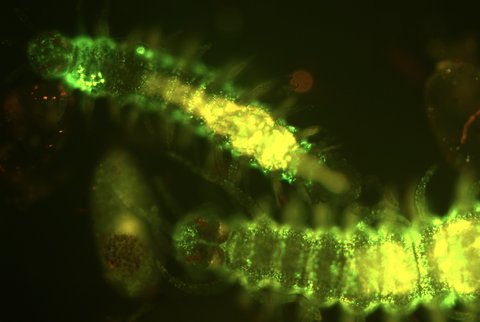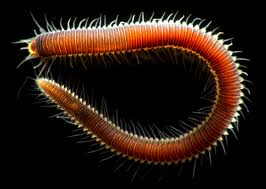Life Cycle
The worm known as the “fireworm”, the Odontosyllis phosphorea reproduces sexually and has separate sexes (Tsuji and Hill, 1983). These worms have a very specific external mating ritual in tune with each month’s quarter moons (Pickett, 2012). The ritual happens one or two days before a quarter moon, begins around 30 to 40 minutes after sunset, and lasts around 20 to 30 minutes (Pickett, 2012). O. phosphorea females start the ritual by rising from their underwater benthic level habitat and swim towards the surface (Deheyn and Latz, 2009). The female worms produce bioluminescent blue-green mucus while slowly swimming in circles releasing gametes about two centimeters below the surface of the water (Jones and Wood, 2006). The glow allows the males visual indicators of the position of the females’ gametes. Males also emit short pulses of light while swim up towards the surface of the water to release their gametes (Jones and Wood, 2006). Watch the awesome video below of the sister species Odontosyllis enola during their identical mating ritual (Figure 1.). More than one male will take place in germinating the females’ eggs since all gametes, male and female, are released into the surrounding water (Jones and Wood, 2006). In a study of Odontosyllis enopla, a sister species of Odontosyllis phosphorea, Galloway and Welch took random samples of the water surrounding the fireworms after the spawning event and found that 45-80 percent of the eggs were fertilized, which shows the efficiency of the worms reproductive strategy (Jones and Wood, 2006). Explained more in the interactions page the O. phosphorea females also use their blue-green glow as a defense mechanism (Pickett, 2012).
Figure 1. Video of Burmuda glow worms, Odontosyllis enola. Promission courtesy of greydek. This video was taken by greydek September 14th 2011. Check out his other videos of marine organisms at http://www.youtube.com/user/graydek?feature=watch.
Dr. Dimitri Deheyn, a well-known Marine Biologist at the University of California-San Diego studied the time period of the ritual and glow of the O. phosphorea. Regarding the question of if the bioluminescence is long enough to be seen by the male O. phosphorea, Dr. Deheyn said,
 “Well, it’s long enough. [The swarming] happens at twilight,
so the daytime predators have gone to bed and the nighttime
predators haven’t become active yet, but they still have to
balance making enough light for their sexual partner to find
them without making too much light, which could attract
predators. To us it doesn’t seem like much light, but for them,
it is enough”(Pickett, 2012).
“Well, it’s long enough. [The swarming] happens at twilight,
so the daytime predators have gone to bed and the nighttime
predators haven’t become active yet, but they still have to
balance making enough light for their sexual partner to find
them without making too much light, which could attract
predators. To us it doesn’t seem like much light, but for them,
it is enough”(Pickett, 2012).
Figure 2. Bioluminescence of O. phosphorea. Image courtesy of Dimitri Deheyn, Scripps Institution of Oceanography at UC San Diego.
This quote does a great job of showing the balance of sexual selection and predation. Learn more about what prays on Odontosyllis phosphorea on our interactions page.
Know that the ultimate question of why
O. phosphorea secretes
their bioluminescent mucus, lets ask the proximate question of
how the bioluminescent occurs. A study done by Dimitri D. Deheyn
and Michael I. Latz was done to test if the bioluminescence was
due to a photoprotein or if it is do to a luciferin-luciferase
reaction-taking place within the organism similar to other
bioluminescent organisms (Deheyn and Latz, 2009). Luciferin
reactions and photoprotein are very similar bioluminescent
reactions (Wilson, 2008). Luciferase acts as a catalyst for
luciferin to combine with oxygen, and it is the luciferase
catalyst that actually emits photons of light (Wilson, 2008).
Photoproteins are proteins that generate light when oxidized
without the aid of any enzyme (Wilson, 2008).
 The conclusion
made from the study was that O. phosphorea use photoproteins
instead of a luciferase reaction, but could not pinpoint a
specific photoprotein (Deheyn and Latz, 2009). Although the
study was not successful at finding a specific photoprotein in
charge of O. phosphorea’s bioluminescent, the results from their
study will help further studies on the purification and
identification of compounds involved (Deheyn and Latz, 2009).
Check out
Noctiluca scintillans and
Photinus pyralis different orgainsims that use
luciferin-luciferase reaction instead of photoproteins like
Odontosyllis phosphorea.
The conclusion
made from the study was that O. phosphorea use photoproteins
instead of a luciferase reaction, but could not pinpoint a
specific photoprotein (Deheyn and Latz, 2009). Although the
study was not successful at finding a specific photoprotein in
charge of O. phosphorea’s bioluminescent, the results from their
study will help further studies on the purification and
identification of compounds involved (Deheyn and Latz, 2009).
Check out
Noctiluca scintillans and
Photinus pyralis different orgainsims that use
luciferin-luciferase reaction instead of photoproteins like
Odontosyllis phosphorea.
Figure 3. O. phosphorea. Picture taken by Greg Rouse.
Next Page: Interactions